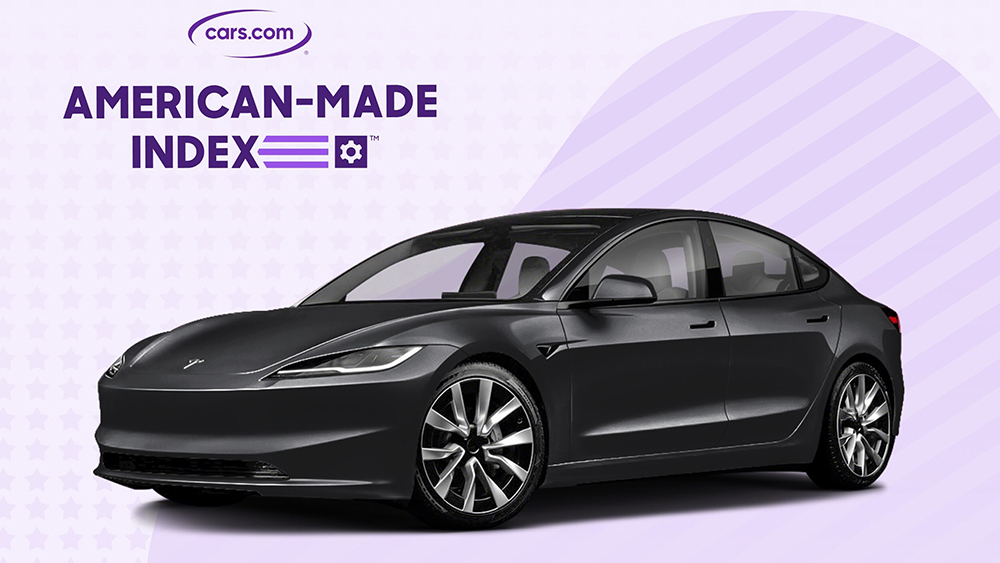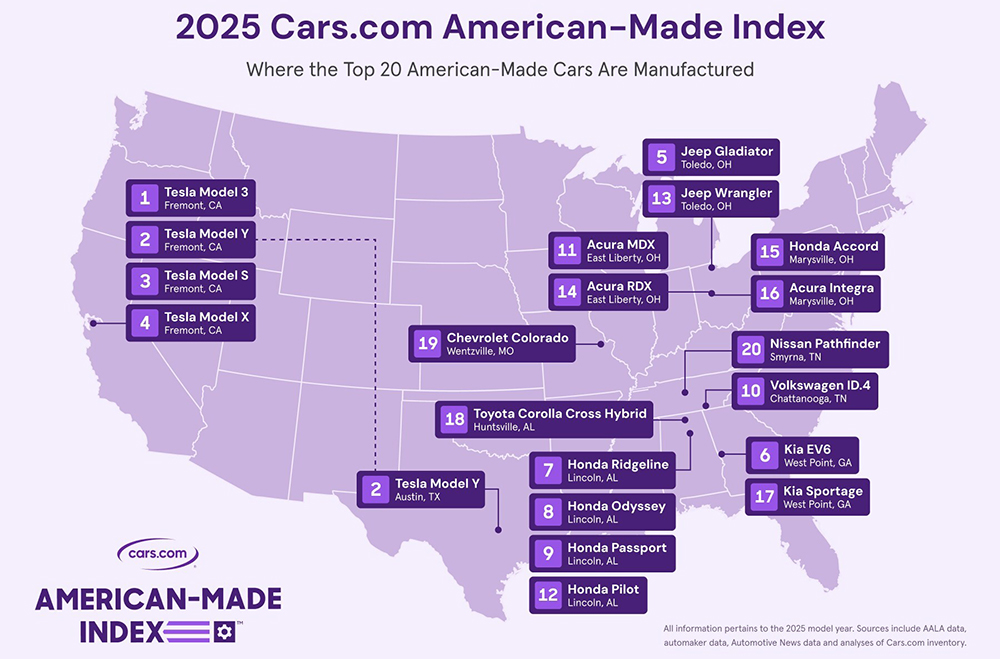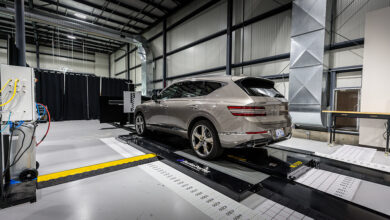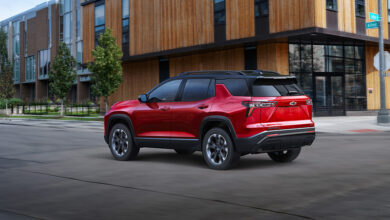Report: Cars.com’s 2025 American-Made Index Results
Tesla takes first four spots & Jeep rounds out top five, as 70% of Americans consider American-made to avoid tariff costs…

Car-shopping marketplace Cars.com unveiled its 20th annual American-Made Index (AMI). Released amid rising tariffs and inflationary pressures, this year’s index reflects growing consumer urgency to understand where cars are made, according to company officials in a press report. Cars.com experts independently evaluated more than 400 vehicles from the 2025 model year to identify the 99 that contribute most to the U.S. economy through manufacturing, parts sourcing and employment. This release marks 20 years of Cars.com tracking America’s evolving auto manufacturing footprint, as consumer behavior and economic policy converge.
Texas-based Tesla leads the 2025 list, claiming the top four spots for the second time since its debut on the index in 2020. After holding the No. 1 position for three consecutive years with the Model Y, Tesla now leads with the Model 3, followed by the Models Y, S and X. Rounding out the top five is the Jeep Gladiator, making it the highest-ranked American-made pickup truck.
Automakers like Honda stand out for consistency and scale, according to the report. Its Alabama facility produces five of this year’s top 20 vehicles, including the Ridgeline, Odyssey, Passport, Pilot and Acura MDX. GM remains a dominant player with the most vehicles on this year’s index. Kia’s West Point, Georgia, plant builds both the EV6 and Sportage, while Volkswagen’s Chattanooga, Tennessee, facility produces the ID.4, one of only two non-Tesla EVs in the top 20.
“As import tariffs shake up the auto industry and influence consumer priorities, our 2025 American-Made Index offers a timely snapshot of which vehicles and automakers are truly driving U.S. economic impact,” said Patrick Masterson, lead researcher for Cars.com’s American-Made Index. “Tesla continues to lead, claiming the top four spots and showcasing its commitment to domestic production. About 25% of the more than 400 vehicles on sale in the U.S. made this year’s AMI, and whether a vehicle is No. 1 or No. 99, it contributes to the U.S. economy.”
Top 20 Vehicles on the 2025 American-Made Index |
|||
| Rank | Model | Rank | Model |
| 1 | Tesla Model 3 | 11 | Acura MDX |
| 2 | Tesla Model Y | 12 | Honda Pilot |
| 3 | Tesla Model S | 13 | Jeep Wrangler |
| 4 | Tesla Model X | 14 | Acura RDX |
| 5 | Jeep Gladiator | 15 | Honda Accord |
| 6 | Kia EV6 | 16 | Acura Integra |
| 7 | Honda Ridgeline | 17 | Kia Sportage |
| 8 | Honda Odyssey | 18 | Toyota Corolla Cross Hybrid |
| 9 | Honda Passport | 19 | Chevrolet Colorado |
| 10 | Volkswagen ID.4 | 20 | Nissan Pathfinder |
Cars.com Surveys Reveal Buying American-Made Is Becoming a Strategy
Global complexity is now front and center for car shoppers. According to a recent Cars.com survey, more than half say they’ve accelerated their vehicle purchase timeline to avoid tariff-driven price hikes. According to a Cars.com survey of in-market shoppers, 51% say tariffs have influenced them to seek out American-made vehicles.
That motivation runs deeper, with 73% of shoppers saying they’d consider an American-built vehicle to avoid added tariff costs. And some shoppers said they’d pay extra if that means supporting U.S. jobs, with 74% saying they are willing to pay up to 20% more. In today’s market, “American-made” isn’t just a preference—it’s becoming a strategy, noted the Cars.com press release.
Where America Builds & Why It Matters
The 2025 AMI reflects major geographic and strategic shifts, says Cars.com. In total, the index includes vehicles produced at 36 factories across the country. That’s out of the 47 total assembly plants in operation, meaning the majority of the U.S. auto production is represented in this year’s ranking, but there are still 11 factories not represented on the list because they produce vehicles that are specialty, boutique or vehicles that do not fall in the light-duty category.
Among these 36 ranked facilities, 50% are located in the South and 47% in the Midwest, reflecting an overall balance of legacy and emerging manufacturing hubs. Alabama accounts for 17% of all factories on the list, followed by Michigan and Indiana with 15% and 14%. These plants are producing high-impact models from automakers like Honda, Toyota, GM, Stellantis, Kia and Volkswagen.

20 Years of the AMI: Evolving With the Industry
“No vehicle has ever reached 100% domestic parts content in the index’s history,” notes Masterson. “Manufacturing is a complex, international process, and even our most American-made vehicles still depend on global supply chains.”
Over time, Cars.com says that one trend has become clear: full domestic content is elusive. The average domestic parts content of the top 10 vehicles was 83.4% in 2006; today, it’s 70.3%. While that figure has risen slightly in recent years, it underscores how globally integrated auto production has become.



